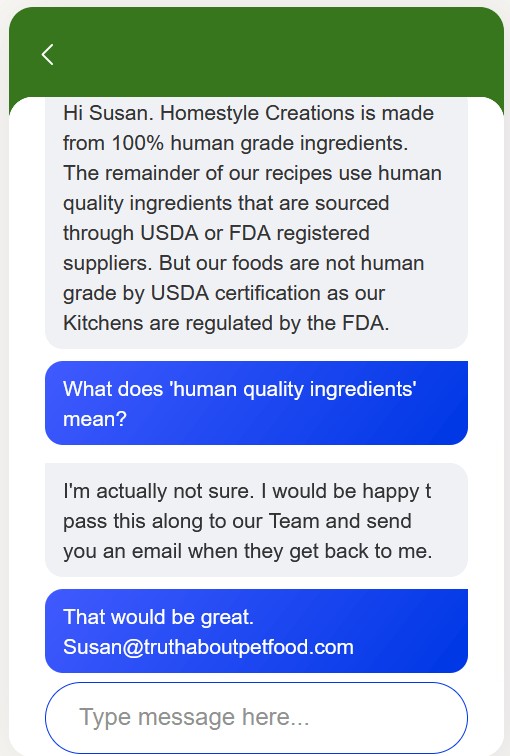Freshpet is a popular brand of pet food that has made waves with its marketing, often suggesting its products are akin to human food. You might have seen their commercials or website, perhaps even pondered if Freshpet is so wholesome, could humans eat it too? As pet experts at pets.edu.vn, we delve into this question and unpack the reality behind Freshpet’s “human quality” claims.
Freshpet’s marketing often blurs the lines between pet food and human food. A screenshot from their website and recent television commercials give the impression that their pet food is virtually the same quality as what we eat.
 Freshpet website suggesting human food quality
Freshpet website suggesting human food quality
To get to the bottom of this, we directly contacted Freshpet to verify if their pet food is truly manufactured to human food safety standards or if it’s considered feed grade. We specifically asked if the ingredients in their pet foods are human grade.
In their own words, Freshpet admitted that their products are not human grade and are not manufactured in a licensed human food facility. They are categorized as feed grade pet food.
Freshpet states that “the remainder of our recipes use human quality ingredients that are sourced through USDA or FDA registered suppliers.” However, this statement needs further examination. While it’s true that ingredient suppliers must be registered with the USDA or FDA, this registration doesn’t automatically equate to “human edible” quality in the way consumers might understand it – food safe enough to store next to their own groceries. Ingredients from USDA or FDA registered suppliers can still include condemned and diseased animal materials, which are permissible in feed grade pet food but not in human grade food.
Human Grade vs. Feed Grade: Understanding the Critical Differences
The distinction between human grade and feed grade pet food is significant, particularly in manufacturing standards. Human grade pet food, labeled as such, must adhere to stringent regulations:
- 100% Human Edible Ingredients: Every ingredient, including supplements, must be legally defined as safe and edible for human consumption.
- Human Food Facility Manufacturing: Production must occur in facilities licensed to produce human food, complying with federal and state food safety standards.
- USDA Inspection: For pet foods containing more than 3% meat (which includes human grade options), the USDA mandates continuous on-site inspection during all operating hours. Inspectors ensure adherence to safety standards, verify human edibility of ingredients, proper refrigerated storage, and maintain clean manufacturing conditions.
Feed grade pet food operates under a different set of rules. It is NOT required to meet human food standards.
- No Mandatory USDA On-site Inspection: There’s no requirement for continuous USDA oversight to guarantee human edible ingredients, proper ingredient storage, or pristine manufacturing environments.
A stark example of the difference in standards is revealed in an FDA inspection report of a Mars Petcare feed grade facility, obtained through the Freedom of Information Act. The report detailed alarming “Inspectional Observations”:
“1. Failure to inspect, segregate, or otherwise handle raw materials and ingredients used in manufacturing under conditions that will protect the animal food against contamination and minimize deterioration.”
“2. Failure to take effective measures to exclude pests from your plant and protect against contamination of animal food by pests…”
Disturbingly, the report also documented “millions of roaches” infesting the food production area. Despite these severe violations – conditions that would be utterly unacceptable in human food production – no recall or warning letter was issued. This is because such conditions, while appalling, can be considered acceptable within the less rigorous framework of feed grade manufacturing.
While not all feed grade facilities are infested with pests or have lax ingredient handling, the crucial point is that they can be, and the regulatory system permits it. Consumers are largely unaware of which facilities maintain high standards and which do not.
“Human Quality Ingredients”: A Marketing Term, Not a Legal Definition
Freshpet’s use of “human quality ingredients” is a marketing phrase, not a legally defined term in pet food regulations. It suggests a high standard, but it doesn’t guarantee human grade quality or manufacturing processes. As highlighted earlier, even ingredients from USDA/FDA registered suppliers can be feed grade and include materials not fit for human consumption.
Is Freshpet’s Marketing Misleading?
Considering these facts, it’s reasonable to question if Freshpet’s marketing tactics are misleading. By heavily implying a human food equivalence without actually being human grade, are they intentionally leading pet owners to believe their food is of a higher standard than it truly is?
Furthermore, the question arises: Should feed grade pet food, manufactured under less stringent standards, be stored in your refrigerator alongside human food? This is a question every pet owner needs to consider.
Making Informed Choices for Your Pet
Ultimately, being an informed pet owner is paramount. While Freshpet may offer a refrigerated alternative to traditional kibble, understanding its feed grade classification and the differences in manufacturing standards is crucial. Don’t rely solely on marketing buzzwords. Investigate beyond the surface to ensure you’re making the best and most informed decisions for your beloved companion’s health and well-being.
For more insights into pet food safety and informed pet care, continue to follow pets.edu.vn, your trusted source for pet expertise.
